| << Chapter < Page | Chapter >> Page > |
To test our code, we simulated flows past two different types of obstacles – a flat plate and a circular cylinder – and also examined the effects of choosing different subdomain sizes over which to average. All simulations were carried out on a grid 640 nodes by 256 nodes in dimension with 2000 timesteps. The resulting flow fields were:
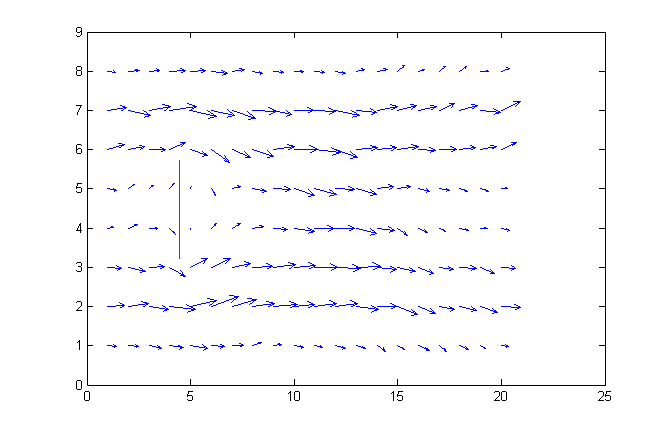
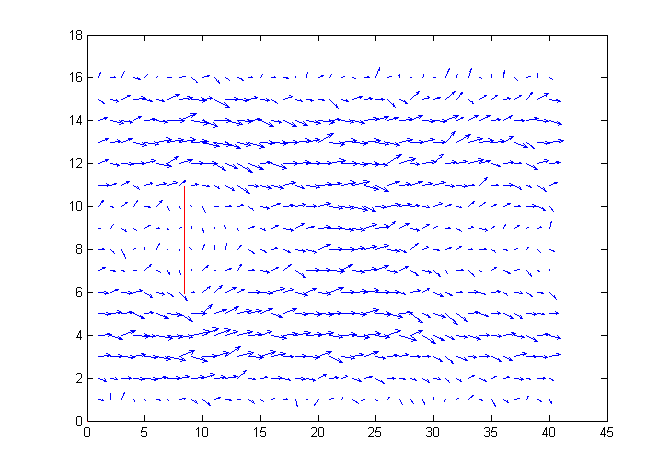
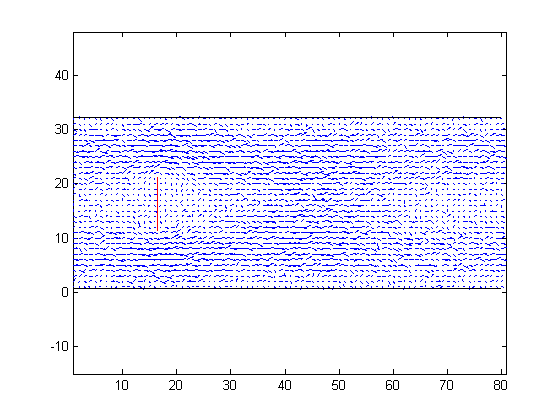
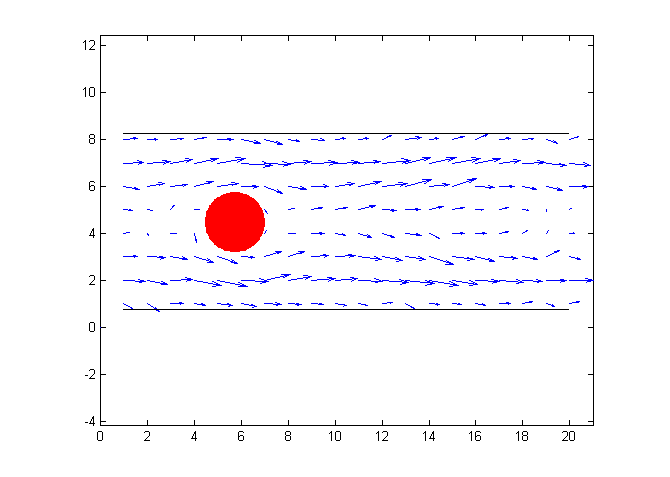
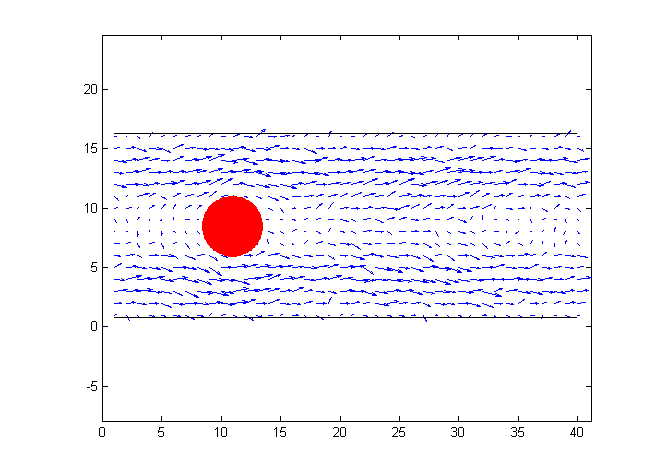
Though lattice gas models are convenient, they suffer from several drawbacks, the most notable of which is statistical noise. As the figures in the previous section illustrate, there is a significant tradeoff between flow field accuracy and model detail for a fixed domain size. As with any type of simulation, it is possible to get better, more accurate and detailed results by simply enlarging the domain and taking a greater number of timesteps. Unfortunately, thismeans a larger consumption of computing resources. Generating each of the above figures using the code below took between three and four hours of time on a Dell Latitude D410 laptop running MATLAB on Windows XP with 1 GB RAM and a 2 GHz Intel processor. To enlarge the domain by 10 times in each dimension and take 10 times as many timesteps, as is done in generating the figures on pages 83-84 of [link] , would require a enormous amount of memory and runtime. To make the simulation usable, it will be necessary in the future to improve the simulation algorithm (e.g., by implementing it on a bitwise level as discussed on pg. 42 of [link] ). Additionally, this model lends itself easily to parallelization, providing another possibility for performance improvement.
We have successfully implemented the basic version of the FHP lattice gas cellular automaton for simulating fluid behavior. Though our present implementation is a bit inefficient, it appears to give the expected results, and we know ways that it may be improved. Assembling this model has allowed us to take a step in the direction of our ultimate goal is of investigating the motion of vibrating strings in fluids.
This Connexions module describes work conducted as part of Rice University's VIGRE program, supported by National Science Foundationgrant DMS–0739420.
%
% fhp_.m -- Uses the FHP LGCA model to simulate the flow of a fluid% past a plate in a wide channel with no-slip
% boundary conditions. This code aims to implement the FHP% LGCA as described in_ Lattice Gas Cellular Automata and
% Lattice Boltzmann Models_ by Wolf-Gladrow. Periodic% boundary conditions are assumed at the channel's left
% and right edges.%
% WRITTEN BY: Anthony P. Austin, February 11, 2009function fhp
tic; % Time program exectution.% Number of nodes in each direction. These must be multiples of 32
% for the coarse graining to work.numnodes_x = 6400/10;
numnodes_y = 2560/10;% Number of timesteps over which to simulate.
t_end = 5;% 3D array of nodes to store the vectors that represent the occupied
% cells at each node.% 0 - Cell unoccupied.
% 1 - Cell occupied.%
% 1st Index -- Node x-coordinate.% 2nd Index -- Node y-coordinate.
% 3rd Index -- Cell number%
% The elements of the occupancy vectors correspond to the cells in the
% following way:%
% 3 2% \ /
% 4 - O - 1% / \
% 5 6%
% Observe that this convention differs slightly from Wolf-Gladrow's.%
nodes = zeros(numnodes_x, numnodes_y, 6);% Define the lattice velocities.
c1 = [1; 0];
c2 = [cos(pi/3); sin(pi/3)];
c3 = [cos(2*pi/3); sin(2*pi/3)];
c4 = [-1; 0];
c5 = [cos(4*pi/3); sin(4*pi/3)];
c6 = [cos(5*pi/3); sin(5*pi/3)];% Define a matrix that indicates where the flow obstacles are.
% 0 - No obstacle present at that node.% 1 - Obstacle at the node.
%% Don't forget to put 1's at the interior points, too!
obstacle = zeros(numnodes_x, numnodes_y);% Insert a flat plate as the obstacle.
for (j = 880/10:1:1680/10)obstacle(1280/10, j) = 1;
end% Insert a circular cylinder as the obstacle.%{
theta = 0:0.001:2*pi;xc = round(168 + 40*cos(theta));
yc = round(128 + 40*sin(theta));for (i = 1:1:length(theta))obstacle(xc(i), yc(i)) = 1;
endfor (i = 1:1:numnodes_x)currrow = obstacle(i, :);
n = find(currrow, 1, 'first');m = find(currrow, 1, 'last');if (~isempty(n))
for (j = n:1:m)obstacle(i, j) = 1;
endend
end%}% Set up the simulation.
for (i = 1:1:numnodes_x)for (j = 2:1:(numnodes_y - 1)) % Don't include the top and bottom walls.
% Skip points on the obstacle boundaryif (obstacle(i, j) ~= 1)
curr_cell = nodes(i, j, :); % Get the cell for the current node.curr_cell(1) = 1; % Put a particle in the cell flowing in the
% rightward direction.nodes(i, j, :) = curr_cell; % Reinsert the cell into the array.end
endend
% Carry out the simulation.for (t = 1:1:t_end)% Carry out collisions at non-boundary nodes.
for (i = 1:1:numnodes_x)for (j = 2:1:(numnodes_y - 1)) % Don't include the top and bottom walls.
% Ensure that there's no obstacle in the way.if (obstacle(i, j) ~= 1)% Extract the current cell.
cell_oc = nodes(i, j, :);% Determine how many particles are in the cell.
numparts = sum(cell_oc);% Determine and execute appropriate collision.
if ((numparts ~= 2)&&(numparts ~= 3)) % No collision occurs.
nodes(i, j, :) = cell_oc;elseif (numparts == 3) % Three-particle collisions.
% We require a symmetric configuration.if ((cell_oc(1) == cell_oc(3))&&(cell_oc(3) == cell_oc(5)))
% Invert the cell contents.nodes(i, j, :) = ~cell_oc;
elsenodes(i, j, :) = cell_oc;
endelse % Two-particle collisions.
% Find the cell of one of the particles.p1 = find(cell_oc, 1);
% We need its diametric opposite to be occupied as well.if ((p1>3) || (cell_oc(p1 + 3) ~= 1))
nodes(i, j, :) = cell_oc;else
% Randomly rotate the particle pair clockwise or% counterclockwise.
r = rand;if (r<0.5) % Counterclockwise.
n_cell_oc(1) = cell_oc(6);n_cell_oc(2) = cell_oc(1);
n_cell_oc(3) = cell_oc(2);n_cell_oc(4) = cell_oc(3);
n_cell_oc(5) = cell_oc(4);n_cell_oc(6) = cell_oc(5);
else % Clockwise.n_cell_oc(1) = cell_oc(2);
n_cell_oc(2) = cell_oc(3);n_cell_oc(3) = cell_oc(4);
n_cell_oc(4) = cell_oc(5);n_cell_oc(5) = cell_oc(6);
n_cell_oc(6) = cell_oc(1);endnodes(i, j, :) = n_cell_oc;
endend
endend
end% Carry out collisions along the top and bottom walls (no-slip).
for (i = 1:1:numnodes_x)nodes(i, 1, :) = [nodes(i, 1, 4) nodes(i, 1, 5) nodes(i, 1, 6) nodes(i, 1, 1) nodes(i, 1, 2) nodes(i, 1, 3)];nodes(i, numnodes_y, :) = [nodes(i, numnodes_y, 4) nodes(i, numnodes_y, 5) nodes(i, numnodes_y, 6) nodes(i, numnodes_y, 1) nodes(i, numnodes_y, 2) nodes(i, numnodes_y, 3)];end% Carry out collisions at obstacle points (no-slip).
for (i = 1:1:numnodes_x)for (j = 1:1:numnodes_y)
if (obstacle(i, j) == 1)nodes(i, j, :) = [nodes(i, j, 4) nodes(i, j, 5) nodes(i, j, 6) nodes(i, j, 1) nodes(i, j, 2) nodes(i, j, 3)];end
endend% Create a new lattice which will hold the state of the current
% lattice after propagation.n_nodes = zeros(numnodes_x, numnodes_y, 6);
% Iterate over all the nodes, propagating the particles as we go.for (i = 1:1:numnodes_x)
for(j = 1:1:numnodes_y)% Get the occupancy state of the current node.
cell_oc = nodes(i, j, :);% Coordinates of the neighbor node.
neighbor_x = 0;neighbor_y = 0;
% Propagation in the 1-direction.neighbor_y = j;
if (i == numnodes_x)neighbor_x = 1;
elseneighbor_x = i + 1;
endn_cell_oc = n_nodes(neighbor_x, neighbor_y, :);
n_cell_oc(1) = cell_oc(1);n_nodes(neighbor_x, neighbor_y, :) = n_cell_oc;
% Propagation in the 2-direction.if (j ~= numnodes_y)
neighbor_y = j + 1;if (mod(j, 2) == 0)
if (i == numnodes_x)neighbor_x = 1;
elseneighbor_x = i + 1;
endelse
neighbor_x = i;end
n_cell_oc = n_nodes(neighbor_x, neighbor_y, :);n_cell_oc(2) = cell_oc(2);
n_nodes(neighbor_x, neighbor_y, :) = n_cell_oc;end
% Propagation in the 3-direction.if (j ~= numnodes_y)
neighbor_y = j + 1;if (mod(j, 2) == 1)
if (i == 1)neighbor_x = numnodes_x;
elseneighbor_x = i - 1;
endelse
neighbor_x = i;end
n_cell_oc = n_nodes(neighbor_x, neighbor_y, :);n_cell_oc(3) = cell_oc(3);
n_nodes(neighbor_x, neighbor_y, :) = n_cell_oc;end
% Propagation in the 4-direction.neighbor_y = j;
if (i == 1)neighbor_x = numnodes_x;
elseneighbor_x = i - 1;end
n_cell_oc = n_nodes(neighbor_x, neighbor_y, :);n_cell_oc(4) = cell_oc(4);
n_nodes(neighbor_x, neighbor_y, :) = n_cell_oc;% Propagation in the 5-direction.
if (j ~= 1)neighbor_y = j - 1;
if (mod(j, 2) == 1)if (i == 1)
neighbor_x = numnodes_x;else
neighbor_x = i - 1;end
elseneighbor_x = i;
endn_cell_oc = n_nodes(neighbor_x, neighbor_y, :);
n_cell_oc(5) = cell_oc(5);n_nodes(neighbor_x, neighbor_y, :) = n_cell_oc;
end% Propagation in the 6-direction.
if (j ~= 1)neighbor_y = j - 1;
if (mod(j, 2) == 0)if (i == numnodes_x)
neighbor_x = 1;else
neighbor_x = i + 1;end
elseneighbor_x = i;
endn_cell_oc = n_nodes(neighbor_x, neighbor_y, :);
n_cell_oc(6) = cell_oc(6);n_nodes(neighbor_x, neighbor_y, :) = n_cell_oc;
endend
end% Propagate the particles to their next nodes.nodes = n_nodes;% Print the current time step every so often so we know that the
% program hasn't frozen or crashed.if (mod(t, 5) == 0)
disp(t);end
end% Subdivide the total domain into subdomains of size 32x32 for the% purposes of coarse-graining. See pg. 51.
grain_size = 8;grain_x = numnodes_x / grain_size;
grain_y = numnodes_y / grain_size;% Pre-allocate vectors for the averaged velocities.av_vel_x_coords = zeros(1, grain_x * grain_y);
av_vel_y_coords = zeros(1, grain_x * grain_y);av_vel_x_comps = zeros(1, grain_x * grain_y);
av_vel_y_comps = zeros(1, grain_x * grain_y);% Iterate over the entire domain, averaging and storing the results as% we go.
currval = 1;for (i = 1:1:grain_x)
% Calculate the lower and upper x-boundaries.x_bd_l = (i - 1)*grain_size + 1;
x_bd_u = i*grain_size;for (j = 1:1:grain_y)
% Calculate the lower and upper y-boundaries.y_bd_l = (j - 1)*grain_size + 1;
y_bd_u = j*grain_size;% Get the number of particles moving in each direction in the% current subdomain.
np = zeros(1, 6);np(1) = sum(sum(nodes(x_bd_l:1:x_bd_u, y_bd_l:1:y_bd_u, 1)));
np(2) = sum(sum(nodes(x_bd_l:1:x_bd_u, y_bd_l:1:y_bd_u, 2)));np(3) = sum(sum(nodes(x_bd_l:1:x_bd_u, y_bd_l:1:y_bd_u, 3)));
np(4) = sum(sum(nodes(x_bd_l:1:x_bd_u, y_bd_l:1:y_bd_u, 4)));np(5) = sum(sum(nodes(x_bd_l:1:x_bd_u, y_bd_l:1:y_bd_u, 5)));
np(6) = sum(sum(nodes(x_bd_l:1:x_bd_u, y_bd_l:1:y_bd_u, 6)));% Compute the average velocity.av_vel = (1/(grain_size.^2))*(np(1)*c1 + np(2)*c2 + np(3)*c3 + np(4)*c4 + np(5)*c5 + np(6)*c6);% Store the velocity components.
av_vel_x_comps(currval) = av_vel(1);av_vel_y_comps(currval) = av_vel(2);% Store the positional coordinates.
av_vel_x_coords(currval) = i;av_vel_y_coords(currval) = j;currval = currval + 1;
endend% Plot the average velocity field.
quiver(av_vel_x_coords, av_vel_y_coords, av_vel_x_comps, av_vel_y_comps);% Plot the channel boundaries.hold on;
plot([1; grain_x], [0.75; 0.75], 'k-');hold on;
plot([1; grain_x], [grain_y + 0.25; grain_y + .25], 'k-');% Display the flow obstacle.obstacle_x = zeros(1, nnz(obstacle));
obstacle_y = zeros(1, nnz(obstacle));k = 1;for (i = 1:1:numnodes_x)
for (j = 1:1:numnodes_y)if (obstacle(i, j) == 1)
obstacle_x(k) = 0.5 + (numnodes_x ./ (grain_size .* (numnodes_x - 1))) .* (i - 1);obstacle_y(k) = 0.5 + (numnodes_y ./ (grain_size .* (numnodes_y - 1))) .* (j - 1);
k = k + 1;end
endendhold on;
plot(obstacle_x, obstacle_y, 'r-');axis equal;toc; % Print the time it took to execute.
end

Notification Switch
Would you like to follow the 'The art of the pfug' conversation and receive update notifications?